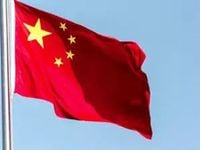Tempers are flaring yet again between two of the world’s economic titans, as the United States and China exchange a volley of threats and countermeasures that could reshape global trade, climate policy, and the future of maritime commerce. In a week marked by escalating rhetoric and policy reversals, both Washington and Beijing have made it clear that neither side intends to back down, raising the stakes for businesses, governments, and consumers across the globe.
On October 10, 2025, the United States issued a stark warning to the international community: any country voting in favor of a proposed carbon tax on maritime transportation could face sanctions and other punitive actions. According to a joint statement issued by US Secretary of State Marco Rubio, Energy Secretary Chris Wright, and Transportation Secretary Sean Duffy, the Biden administration “unequivocally rejects” the Net Zero Framework (NZF) proposal, which is set for a vote next week at the International Maritime Organization (IMO) in London. The NZF aims to reduce global carbon emissions from the shipping sector—a sector responsible for nearly three percent of the world’s greenhouse gas emissions, according to most estimates.
But the US government, under President Donald Trump since January 2025, has reversed course on climate change policy, denouncing international climate efforts as a “scam” and actively encouraging fossil fuel use by rolling back regulations. The administration’s statement minced no words: “We will fight hard to protect our economic interests by imposing costs on countries if they support” the NZF, Rubio and his colleagues declared. The menu of possible penalties is extensive—visa restrictions, blocking vessels registered in supportive countries from US ports, commercial penalties, and even sanctions on government officials. “The United States will be moving to levy these remedies against nations that sponsor this European-led neocolonial export of global climate regulations,” the statement read.
This hardline stance has sent shockwaves through the international community, with many countries now weighing the potential economic fallout of voting for the NZF against their own climate commitments. The US, once a leader in global climate negotiations, is now threatening to punish allies and rivals alike for supporting what it calls a “global carbon tax.” The move marks a dramatic departure from previous US policy, and it has left diplomats scrambling to predict the outcome of the upcoming IMO vote.
Meanwhile, on the other side of the Pacific, China is facing its own set of challenges from Washington. On October 12, 2025, China’s Commerce Ministry responded firmly to a threat by President Trump to impose a 100 percent tariff on all imports from China starting November 1. The threat came after China introduced new restrictions on the export of rare earth elements—materials that are critical for a wide range of consumer and military products, from smartphones and laptops to jet engines and radar systems.
“China’s stance is consistent,” the Commerce Ministry said in an online statement. “We do not want a tariff war but we are not afraid of one.” The ministry urged the US to resolve differences through negotiations rather than threats, and warned that “if the US side obstinately insists on its practice, China will be sure to resolutely take corresponding measures to safeguard its legitimate rights and interests.”
The back-and-forth between the two countries threatens to derail a possible meeting between Trump and Chinese leader Xi Jinping, and could end a fragile truce in a trade war that has already seen tariffs briefly top 100 percent on both sides earlier this year. According to the Commerce Ministry’s statement, “frequently resorting to the threat of high tariffs is not the correct way to get along with China.”
At the heart of this dispute are China’s new regulations on rare earth exports. These rules require foreign companies to obtain special approval to export products containing even small traces of rare earths sourced from China. Given that China controls nearly 70 percent of the world’s rare earth mining and about 90 percent of processing, access to these materials has become a critical bargaining chip in trade negotiations. The ministry noted that export licenses would still be granted for legitimate civilian uses, but acknowledged that the minerals also have significant military applications.
President Trump, for his part, has accused China of “becoming very hostile” and of holding the world “captive” by restricting access to rare earth metals and magnets. The US has responded by expanding the number of Chinese companies subject to export controls and introducing new port fees on Chinese ships—a move that takes effect October 14. In a tit-for-tat response, China announced it would impose its own port fees on American ships.
Both sides accuse each other of violating the spirit of their trade truce, with each imposing new restrictions and controls in recent weeks. The escalation has left businesses and investors on edge, as the world’s two largest economies seem poised for another round of economic confrontation.
The stakes are high. The shipping industry, already battered by supply chain disruptions and the lingering effects of the COVID-19 pandemic, now faces the prospect of new taxes, sanctions, and regulatory uncertainty. The rare earths sector, crucial to the production of everything from electric vehicles to advanced weaponry, is caught in the crossfire of geopolitical rivalry. And for countries caught in the middle—many of whom depend on both US and Chinese markets—the choices are fraught with risk.
Some observers have noted that the US threats against supporters of the NZF could undermine global efforts to combat climate change, just as the world is struggling to limit warming to 1.5 degrees Celsius. Others worry that the escalating tariff war could further destabilize the global economy, disrupt supply chains, and drive up costs for consumers and manufacturers alike.
For now, both Washington and Beijing appear to be digging in their heels, each insisting that the other side is to blame for the breakdown in negotiations. The US is pushing back hard against what it sees as overreach by international climate regulators, while China is leveraging its dominance in rare earths to defend its own economic interests. The rhetoric is fierce, the positions entrenched, and the world is watching closely to see who will blink first.
As the IMO prepares to vote on the Net Zero Framework and the deadline for new tariffs approaches, the coming weeks could prove pivotal—not just for US-China relations, but for the future of global trade and climate policy. The choices made now will echo far beyond the halls of power in Washington and Beijing, shaping the world’s economic and environmental trajectory for years to come.




